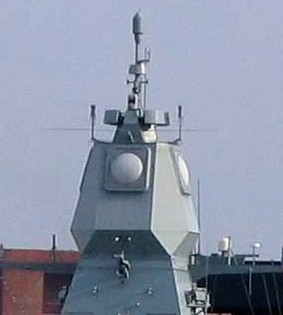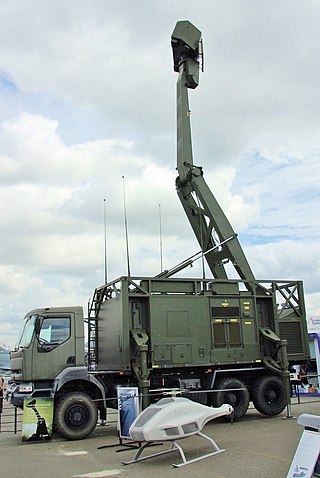
In antenna theory, a phased array usually means an electronically scanned array, a computer-controlled array of antennas which creates a beam of radio waves that can be electronically steered to point in different directions without moving the antennas. The general theory of an electromagnetic phased array also finds applications in ultrasonic and medical imaging application and in optics optical phased array.

The IRIS-T is a medium range infrared homing air-to-air missile available in both air-to-air and ground defence surface-to-air variants. It also is called AIM-2000.

An active electronically scanned array (AESA) is a type of phased array antenna, which is a computer-controlled antenna array in which the beam of radio waves can be electronically steered to point in different directions without moving the antenna. In the AESA, each antenna element is connected to a small solid-state transmit/receive module (TRM) under the control of a computer, which performs the functions of a transmitter and/or receiver for the antenna. This contrasts with a passive electronically scanned array (PESA), in which all the antenna elements are connected to a single transmitter and/or receiver through phase shifters under the control of the computer. AESA's main use is in radar, and these are known as active phased array radar (APAR).

The AN/MPQ-64 Sentinel is an X-band electronically steered pulse-Doppler 3D radar system used to alert and cue Short Range Air Defense (SHORAD) weapons to the locations of hostile targets approaching their front line forces. It is currently produced by Raytheon Missiles & Defense.

NASAMS is a distributed and networked short- to medium-range ground-based air defense system developed by Kongsberg Defence & Aerospace (KDA) and Raytheon. The system defends against unmanned aerial vehicles (UAVs), helicopters, cruise missiles, unmanned combat aerial vehicles (UCAVs), and fixed wing aircraft, firing any of a wide range of existing missiles.

The Type 052C destroyer is a class of guided-missile destroyers in the Chinese People's Liberation Army Navy Surface Force (PLAN). The Type 052C introduced both fixed active electronically scanned array (AESA) radar and vertically launched surface-to-air missiles into PLAN service, making it the first Chinese warship with area air defence capability.

The AN/APG-79 is a type of active electronically scanned array (AESA) radar that was developed for use on the United States Navy's Boeing F/A-18E/F Super Hornet and Boeing EA-18G Growler aircraft. The radar's AESA technology provides quick updates on multiple targets, and its solid-state antenna construction makes it more reliable and cost-effective than traditional radar systems. The radar has a range of up to 150 km and can track multiple targets simultaneously. It is capable of firing weapons such as the AIM-120 AMRAAM's D model and guiding multiple missiles to targets located at varying distances and directions. As of July 2008, 100 APG-79 sets had been delivered to the United States Navy, and the Navy expects to order around 437 production radars. In January 2013, the Director, Operational Test & Evaluation (DOT&E) disclosed some issues with the APG-79 radar during its initial operational testing, but upgrades have been made over time.
The Royal Australian Navy, although a significant force in the Asia-Pacific region, is nonetheless classed as a medium-sized navy. Its fleet is based around two main types of surface combatant, with limited global deployment and air power capability. However, in 2009, a white paper, Defending Australia in the Asia Pacific Century: Force 2030, was produced by the Australian government which set out a programme of defence spending that will see significant improvements to the RAN's fleet and capabilities.

The four De Zeven Provinciën-class frigates are air-defence and command frigates in service with the Royal Netherlands Navy. This class of ships is also known as "LCF". The ships are similar to the German Sachsen-class frigates in role and mission.

Active Phased Array Radar (APAR) is a shipborne active electronically scanned array multifunction 3D radar (MFR) developed and manufactured by Thales Nederland. The radar receiver modules are developed and built in the US by the Sanmina Corporation.

The Saab Giraffe Radar is a family of land and naval two- or three-dimensional G/H-band passive electronically scanned array radar-based surveillance and air defense command and control systems. It is tailored for operations with medium- and Short Range Air Defense (SHORAD) missile or gun systems, or for use as gap-fillers in a larger air defense system.
Electronics and Radar Development Establishment (LRDE) is a laboratory of the Defence Research & Development Organisation (DRDO), India. Located in C.V. Raman Nagar, Bengaluru, Karnataka, its primary function is research and development of radars and related technologies. It was founded by S. P. Chakravarti, the father of Electronics and Telecommunication engineering in India, who also founded DLRL and DRDL.

The MEKO 200 is a frigate design by the Blohm + Voss shipyard of Germany, as part of the MEKO family of warships.
Swordfish is an Indian active electronically scanned array (AESA) long-range tracking radar specifically developed to counter ballistic missile threat. It will be a part of the Indian Ballistic Missile Defense Programme. First testing of this radar was in March 2009. Main aim of the test was to validate the capabilities of the Swordfish Long Range Tracking Radar (LRTR). "The missile to be hit will be fired from a longer distance than it was in the earlier test. DRDO tested whether the radar could track the incoming missile from that distance or not," said a member of the project. This radar is an acknowledged derivative of the Israeli EL/M-2080 Green Pine long range radar, which is the critical component of that country's Arrow missile defense system. However, it differs from the Israeli system as it employs Indian Transmit Receive modules, signal processing, computers and power supplies. It is also more powerful than the base Green Pine system and was developed to meet India's specific BMD needs.

The AN/SPY-6 is an active electronically scanned array 3D radar under development for the United States Navy (USN). It will provide integrated air and missile defense for Flight III Arleigh Burke-class destroyers. Variants are under development for retrofitting Flight IIA Arleigh Burkes and for installation aboard Constellation-class frigates, Gerald R. Ford-class aircraft carriers, America-class amphibious assault ships, and San Antonio-class amphibious transport docks.

The AN/SPY-1 is a United States Navy 3D radar system manufactured by Lockheed Martin. The array is a passive electronically scanned system and a key component of the Aegis Combat System. The system is computer controlled and uses four complementary antennas to provide 360-degree coverage. The system was first installed in 1973 on USS Norton Sound and entered active service in 1983 as the SPY-1A on USS Ticonderoga. The -1A was installed on ships up to CG-58, with the -1B upgrade first installed on USS Princeton in 1986. The upgraded -1B(V) was retrofitted to existing ships from CG-59 up to the last, USS Port Royal.

EMPAR is a rotating C band multifunction passive electronically scanned array radar that reached IOC in 2006 and was initially built by Selex ES. It is designed to be the principal radar system aboard naval vessels of medium and large sizes. The radar offers full volumetric search coverage, low altitude and surface search, the tracking of multiple targets, and the capability to uplink information for missile guidance.

The TRML is a family of air defense radars first developed by Telefunken and currently produced by Hensoldt. It is a development of the earlier TRMS.

The EL/M-2248 MF-STAR is a multifunction active electronically scanned array naval radar system developed by IAI Elta for maritime installation on warships. It is capable of tracking both air and surface targets and providing fire control guidance. MF-STAR is an acronym of Multi-Function Surveillance, Track And Guidance Radar.
Aselsan EIRS (Early Warning RADAR System) is a new generation S-Band radar, developed for long range early warning purposes, with AESA and digital beamforming antenna architecture. The system developed by Turkish company Aselsan. In addition to air-breathing air targets, EIRS also has the ability to detect and track Ballistic Missiles and targets with stealth technology / low RKA from long range.



















